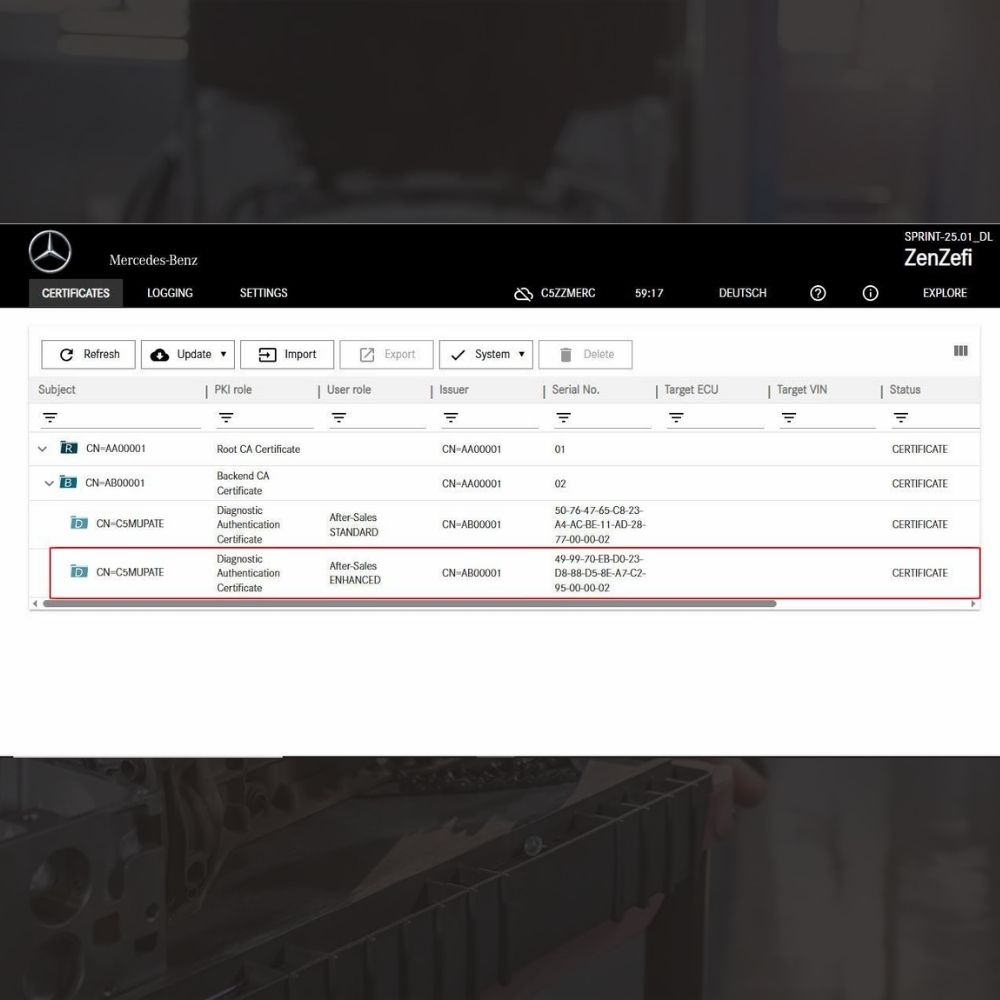
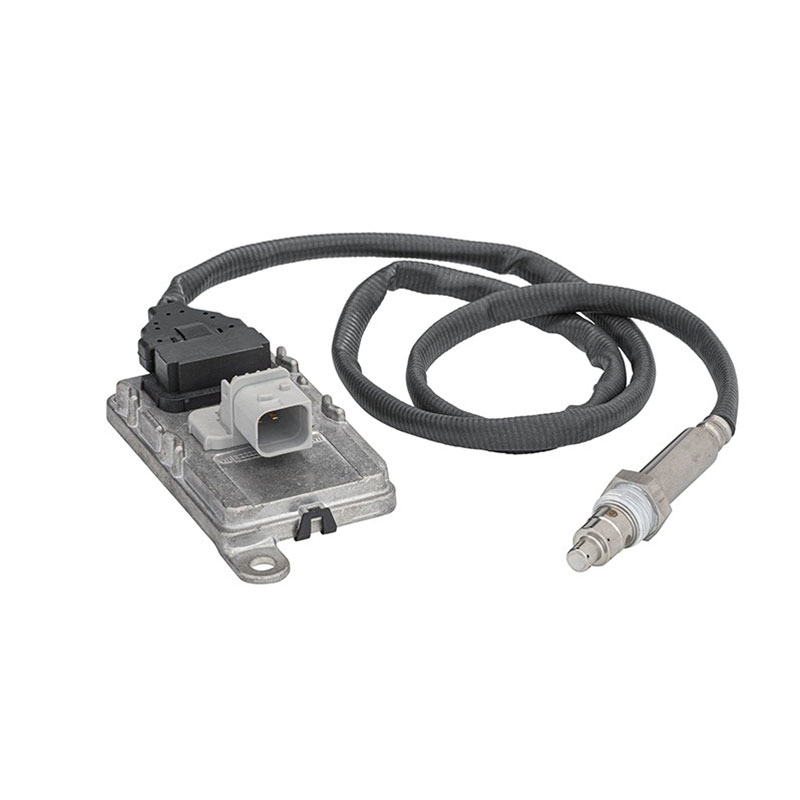
What Is A NOx Sensor And What Does It Do?
Contents
- 1. What Is A NOx Sensor?
- 2. What Does A NOx Sensor Do In A Vehicle?
- 3. How Does A NOx Sensor Work?
- 4. Where Is The NOx Sensor Located In A Vehicle?
- 5. Why Are NOx Sensors Required In Modern Vehicles?
- 6. Are NOx Sensors Used In Both Gasoline And Diesel Engines?
- 7. What Are The Common Symptoms Of A Faulty NOx Sensor?
- 8. How Can You Test A NOx Sensor?
- 9. Common NOx Sensor Error Codes (DTCs):
- 🔧 BMW NOx Sensor Error Codes
- 🔧 Mercedes-Benz NOx Sensor Error Codes
- 🔧 Audi NOx Sensor Error Codes
- 10. Can You Clean A NOx Sensor Instead Of Replacing It?
- 11. How Do You Replace A NOx Sensor?
- 12. What Are The Costs Associated With Replacing A NOx Sensor?
- FAQ About NOx Sensors
- AutoExplain: Your Partner in Automotive Diagnostics and Repair
The NOx sensor is a critical component in modern vehicles that monitors nitrogen oxide levels in exhaust gases to ensure emissions compliance, playing a key role in reducing air pollution. To accurately diagnose and resolve NOx sensor issues, understanding its function, common faults, and testing methods is essential; AutoExplain.com provides expert remote support for these complex automotive systems, offering solutions for emission control and engine management using diagnostic tools and sensor testing. This includes sensor replacement, SCR systems and diesel exhaust fluid management.
1. What Is A NOx Sensor?
A NOx sensor, or nitrogen oxides sensor, is a vital component in modern vehicles used to monitor the levels of nitrogen oxides (NOx) emitted in exhaust gases to ensure compliance with environmental regulations and optimize engine performance. Nitrogen oxides are harmful pollutants formed during the combustion process, and their control is essential for reducing air pollution.
- What are Nitrogen Oxides (NOx)? NOx refers to various nitrogen and oxygen compounds, primarily nitric oxide (NO) and nitrogen dioxide (NO2). These gases are produced when nitrogen in the air reacts with oxygen at high temperatures inside the engine.
- Why are NOx Sensors Important? NOx sensors are crucial because they help control and reduce the emission of harmful pollutants, ensuring vehicles meet stringent environmental standards. They also play a role in optimizing engine efficiency and performance.
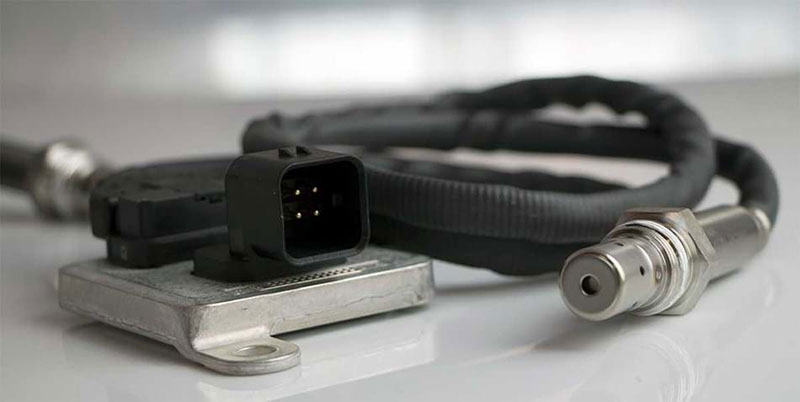
2. What Does A NOx Sensor Do In A Vehicle?
The NOx sensor is a critical component in a vehicle’s exhaust system, responsible for monitoring nitrogen oxide levels and providing feedback to the engine control unit (ECU) to optimize combustion and reduce emissions. The NOx sensor plays a key role in reducing harmful emissions and maintaining environmental compliance.
- How Does a NOx Sensor Monitor NOx Levels? By continuously measuring the amount of nitrogen oxides in the exhaust gas, the sensor provides real-time data to the ECU, allowing the system to adjust engine parameters for optimal performance.
- What is the Role of NOx Sensors in Emission Control Systems? NOx sensors are integral to Selective Catalytic Reduction (SCR) systems, which use a catalyst and a reducing agent (such as urea) to convert NOx into harmless nitrogen and water.
- What Happens If NOx Levels Are Too High? If the NOx sensor detects excessive nitrogen oxides, it triggers the ECU to take corrective actions, such as adjusting the air-fuel mixture or injecting more reducing agent into the SCR system, reducing emissions.
- What Vehicles Commonly Use NOx Sensors? NOx sensors are commonly used in modern diesel and gasoline vehicles to meet strict emission regulations, including heavy-duty trucks, passenger cars, and SUVs.

3. How Does A NOx Sensor Work?
A NOx sensor works by detecting and measuring the concentration of nitrogen oxides (NO and NO₂) in the exhaust gases of an engine, especially in diesel vehicles. It does this using advanced electrochemical technology—similar to a mini gas analyzer—that converts chemical reactions into electrical signals readable by the Engine Control Unit (ECU). Here’s how it works:
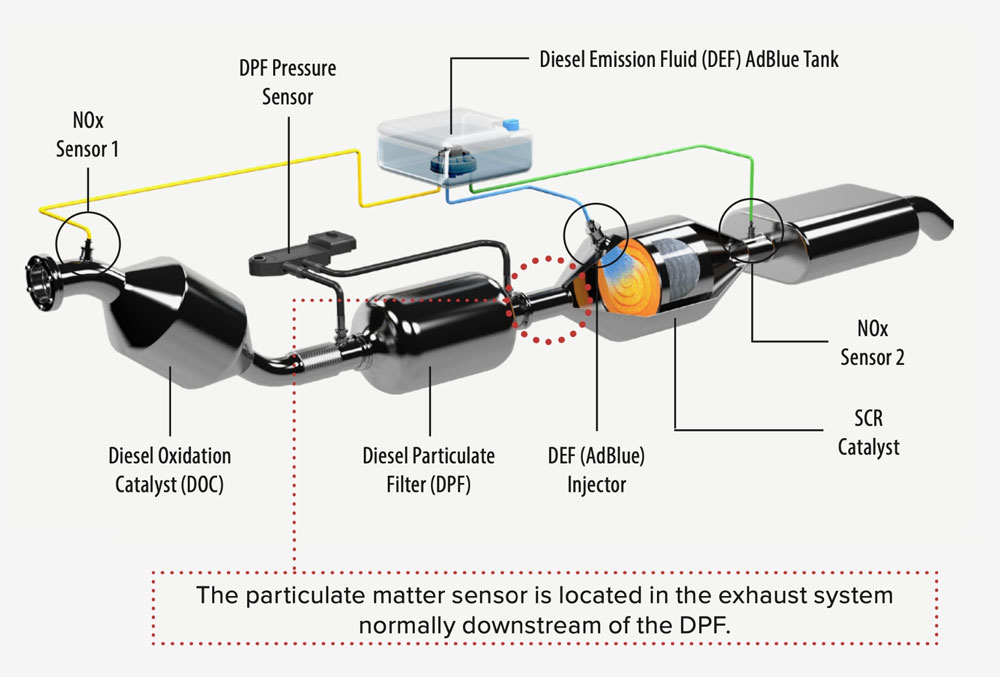
Step 1. Placement in Exhaust System
-
Usually found before and/or after the SCR (Selective Catalytic Reduction) system in the exhaust.
-
Some systems use two NOx sensors: one upstream (before SCR) and one downstream (after SCR) to monitor system efficiency.
Step 2. Gas Sampling
-
Exhaust gases flow over the sensor’s probe, which contains ceramic electrochemical cells.
-
These cells are typically made from yttria-stabilized zirconia (YSZ)—a solid electrolyte.
Step 3. Chemical Reaction
-
Inside the sensor, nitrogen oxides (NO and NO₂) undergo a reduction or oxidation reaction.
-
This reaction generates a small electric current or voltage that is directly proportional to the NOx concentration.
Step 4. Signal Conversion
-
The sensor’s electronics process the electrical signal and convert it into a readable value for the ECU.
-
The ECU uses this data to:
-
Adjust fuel injection timing and air-fuel ratios.
-
Optimize EGR (Exhaust Gas Recirculation) flow.
-
Control AdBlue (DEF) dosing in SCR systems.
-
Step 5. Feedback and Monitoring
-
If NOx levels are too high, the ECU can:
-
Store diagnostic trouble codes (DTCs).
-
Trigger warning lights on the dashboard.
-
Activate engine derating or limp mode in some systems.
-
4. Where Is The NOx Sensor Located In A Vehicle?
The NOx sensor is strategically positioned within the exhaust system to accurately monitor nitrogen oxide levels, and its location can vary depending on the vehicle type and emission control system design. Its placement ensures effective emission monitoring and control.
- Typical Placement of the NOx Sensor: The NOx sensor is commonly located downstream of the Selective Catalytic Reduction (SCR) catalyst in diesel vehicles. This placement allows the sensor to measure NOx levels after the SCR process.
- Why Is the NOx Sensor Located After the SCR Catalyst? Locating the NOx sensor after the SCR catalyst enables the system to verify that the catalyst is effectively reducing nitrogen oxides, ensuring compliance with emission standards.
- Are There Vehicles with Multiple NOx Sensors? Yes, some vehicles may have multiple NOx sensors, including one before the SCR catalyst to monitor initial NOx levels and one after to measure the effectiveness of the SCR system.
- How Does Sensor Placement Affect Performance? The sensor’s location is crucial for accurate monitoring and control, as it provides essential feedback to the engine control unit (ECU) for optimizing combustion and reducing emissions.
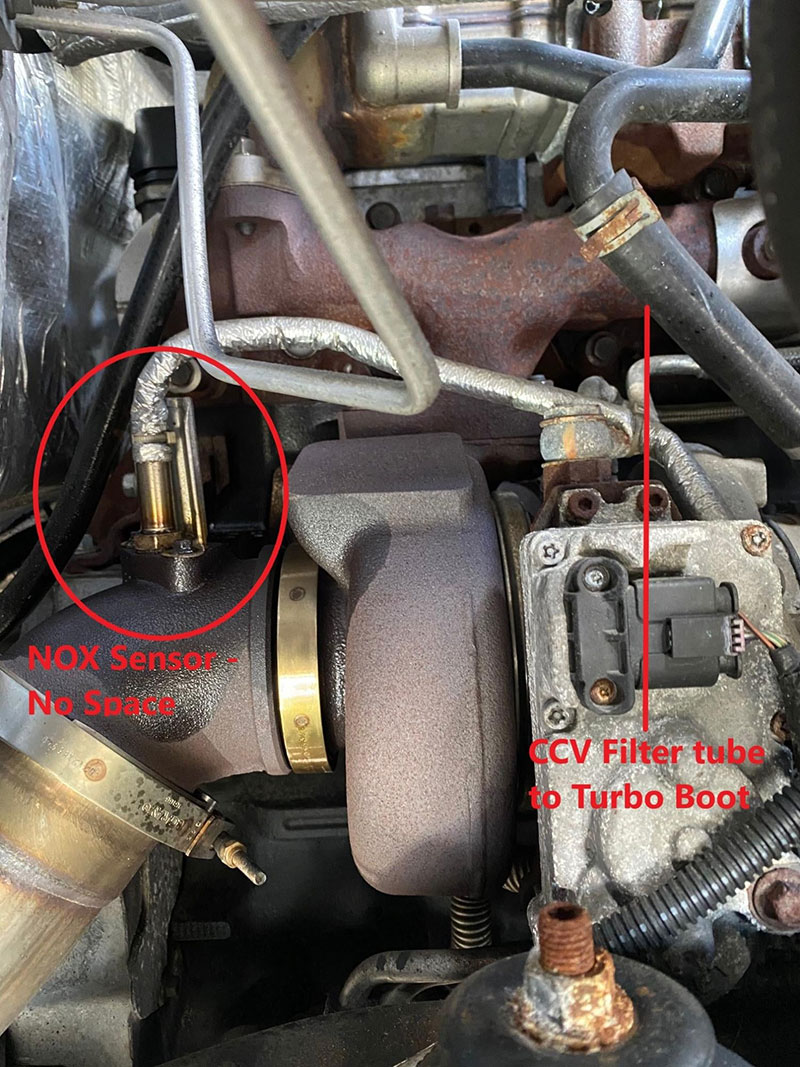
5. Why Are NOx Sensors Required In Modern Vehicles?
NOx sensors are essential in modern vehicles to meet stringent emission regulations, reduce air pollution, and improve overall environmental sustainability. These sensors play a vital role in monitoring and controlling harmful nitrogen oxide emissions.
- How Do NOx Sensors Help Meet Emission Standards? NOx sensors provide real-time data on nitrogen oxide levels, allowing the engine control unit (ECU) to adjust engine parameters and ensure compliance with emission standards like Euro 6 and EPA Tier 3.
- What Role Do NOx Sensors Play in Reducing Air Pollution? By accurately monitoring and controlling NOx emissions, these sensors help reduce smog formation and improve air quality, especially in urban areas.
- How Do NOx Sensors Improve Engine Efficiency? By optimizing the combustion process, NOx sensors enable the engine to operate more efficiently, reducing fuel consumption and lowering overall emissions.
- What Regulations Mandate the Use of NOx Sensors? Governments worldwide have implemented regulations that require the use of NOx sensors in vehicles to minimize environmental impact and protect public health.
6. Are NOx Sensors Used In Both Gasoline And Diesel Engines?
NOx sensors are utilized in both gasoline and diesel engines, but their application and function can vary based on the specific characteristics of each engine type. Their use ensures compliance with emission standards and reduces harmful pollutants.
- NOx Sensors in Diesel Engines: In diesel engines, NOx sensors are essential for managing the higher levels of nitrogen oxides produced due to the combustion process. They work in conjunction with Selective Catalytic Reduction (SCR) systems to reduce NOx emissions.
- NOx Sensors in Gasoline Engines: While gasoline engines generally produce less NOx than diesel engines, modern gasoline vehicles also use NOx sensors to meet stringent emission standards. These sensors help optimize combustion and reduce emissions in gasoline engines.
- Differences in Sensor Design and Functionality: NOx sensors in diesel engines often have more robust designs to withstand the harsh conditions of diesel exhaust systems, while sensors in gasoline engines may be more focused on precise NOx monitoring.
- How Do Sensors Contribute to Overall Emission Reduction? Regardless of the engine type, NOx sensors play a critical role in reducing harmful pollutants, ensuring vehicles meet environmental regulations, and improving air quality.
7. What Are The Common Symptoms Of A Faulty NOx Sensor?
A faulty NOx sensor can cause a range of performance and emission issues, including reduced engine power, increased fuel consumption, and illumination of the check engine light. Recognizing these symptoms is key to timely diagnosis and repair.
- Check Engine Light Illumination: One of the most common signs of a failing NOx sensor is the activation of the check engine light on the dashboard. The engine control unit (ECU) detects abnormal readings from the sensor and triggers the warning.
- Reduced Engine Performance: A faulty NOx sensor can lead to decreased engine power and acceleration due to improper combustion and emission control.
- Increased Fuel Consumption: Inaccurate NOx sensor readings can cause the engine to consume more fuel than normal, leading to higher fuel costs.
- Rough Idling: The engine may exhibit rough idling or stalling, particularly at low speeds, due to incorrect air-fuel mixture adjustments based on faulty sensor data.
- Failed Emission Test: A vehicle with a malfunctioning NOx sensor is likely to fail an emission test, indicating excessive levels of nitrogen oxides.
- Limp Mode Activation: In some cases, the ECU may activate limp mode to protect the engine, limiting vehicle speed and performance.
If you notice any of these symptoms, AutoExplain.com can provide expert remote diagnostics to identify and resolve NOx sensor issues, ensuring your vehicle runs efficiently and meets emission standards. Contact us via WhatsApp at +1(936)2896695 or email at [email protected] for professional assistance.
8. How Can You Test A NOx Sensor?
Testing a NOx sensor involves using diagnostic tools and multimeter measurements to verify its functionality and accuracy, ensuring proper emission control and engine performance. Here’s how you can test a NOx sensor:
- Using a Diagnostic Scan Tool:
- Connect a diagnostic scan tool to the vehicle’s OBD-II port.
- Read and record any diagnostic trouble codes (DTCs) related to the NOx sensor. Common codes include P2200-P2205, indicating circuit malfunctions or signal issues.
- Use the scan tool to monitor live data from the NOx sensor, such as NOx levels and sensor voltage, to check for abnormalities.
- Performing a Multimeter Test:
- Locate the NOx sensor connector and identify the signal, ground, and power wires using a wiring diagram.
- With the engine running, use a multimeter to measure the voltage at the signal wire. Compare the reading to the manufacturer’s specifications.
- Check the sensor’s resistance by disconnecting the sensor and measuring resistance between the appropriate terminals. Again, compare the readings to the manufacturer’s specifications.
- Inspecting the Sensor for Physical Damage:
- Visually inspect the NOx sensor for any signs of physical damage, such as cracks, corrosion, or damaged connectors.
- Check the sensor for soot buildup or contamination, which can affect its performance.
- Interpreting Test Results:
- If the scan tool shows abnormal data or the multimeter readings are outside the specified range, the NOx sensor may be faulty and require replacement.
- Consult the vehicle’s service manual or a professional diagnostic service for detailed troubleshooting steps and accurate interpretation of test results.
For expert assistance with NOx sensor testing and diagnostics, contact AutoExplain.com via WhatsApp at +1(936)2896695 or email at [email protected]. Our team of experienced technicians can provide remote support and guidance to help you accurately diagnose and resolve NOx sensor issues.
9. Common NOx Sensor Error Codes (DTCs):
🔧 BMW NOx Sensor Error Codes
| Code | Description |
|---|---|
| P229F / P229F00 | NOx Sensor 2 Circuit Range/Performance (Bank 1, downstream of SCR). |
| P2200 | NOx Sensor 1 Circuit (Bank 1 – upstream). |
| P2201 | NOx Sensor 1 Circuit Range/Performance (Bank 1 – upstream). |
| P20EE | SCR NOx Catalyst Efficiency Below Threshold. |
| P2BA8 | NOx Sensor Drift; signal out of plausible range. |
| P1030 | NOx Sensor Plausibility Fault or communication error. |
| P2BA0 | NOx Sensor Too Slow to Respond – may indicate sensor degradation. |
🔧 Mercedes-Benz NOx Sensor Error Codes
| Code | Description |
|---|---|
| P229F62 | The signal from NOx sensor downstream of SCR is implausible. |
| P2201 | NOx Sensor 1 Circuit Range/Performance (Bank 1 – upstream). |
| P20E8 | AdBlue Pressure Too Low – can be indirectly caused by sensor misreadings. |
| P13DF00 | NOx Sensor – offset drift detected. |
| P13E400 | NOx sensor reading out of range or sensor failure (often triggers “Engine start not possible in XXX km”). |
| P2BAD | NOx exceeded limit due to sensor malfunction. |
| P20F1 | NOx sensor or SCR malfunction – exceeded threshold. |
=> Related content:
🔧 Audi NOx Sensor Error Codes
| Code | Description |
|---|---|
| P229F | NOx Sensor 2 Circuit Performance (Bank 1 – downstream). |
| P2200 | NOx Sensor 1 Circuit (Bank 1 – upstream). |
| P2202 | NOx Sensor 1 Circuit Low Input (Bank 1). |
| P2203 | NOx Sensor 1 Circuit High Input (Bank 1). |
| P20EE | SCR NOx Catalyst Efficiency Below Threshold. |
| P1030 | NOx sensor data implausible – often due to sensor age or contamination. |
| P2BA6 | NOx Sensor Slow Response. |
10. Can You Clean A NOx Sensor Instead Of Replacing It?
Cleaning a NOx sensor is generally not recommended, as it can cause damage and is unlikely to restore the sensor’s performance. Replacement is usually the best course of action. Here’s why:
- Why Cleaning is Not Recommended:
- Delicate Components: NOx sensors contain delicate internal components that can be damaged by cleaning agents or physical handling.
- Limited Effectiveness: Cleaning may remove surface contaminants, but it cannot address internal damage or wear that affects the sensor’s accuracy and functionality.
- Risk of Damage: Harsh cleaning methods or chemicals can corrode or otherwise damage the sensor, leading to premature failure.
- Self-Cleaning Feature: Some NOx sensors have a self-cleaning function that burns off deposits at high temperatures. However, this process may not be sufficient to restore a heavily contaminated sensor.
- When Replacement is Necessary:
- If a NOx sensor fails diagnostic testing or exhibits symptoms of malfunction, such as check engine light illumination or reduced engine performance, it should be replaced.
- Using a new, high-quality replacement sensor ensures accurate NOx monitoring and proper functioning of the emission control system.
11. How Do You Replace A NOx Sensor?
Replacing a NOx sensor involves careful removal of the old sensor, installation of the new one, and verification of its functionality to ensure proper emission control and engine performance. Here’s a step-by-step guide:
- Tools and Materials Needed:
- New NOx sensor
- Wrench or socket set
- Diagnostic scan tool
- Gloves and safety glasses
- Vehicle service manual
- Step-by-Step Replacement Procedure:
- Preparation:
- Park the vehicle on a level surface, engage the parking brake, and allow the engine to cool down.
- Disconnect the negative battery terminal to prevent electrical shorts.
- Locate the NOx Sensor:
- Refer to the vehicle’s service manual to find the exact location of the NOx sensor in the exhaust system.
- Disconnect the Electrical Connector:
- Carefully disconnect the electrical connector from the NOx sensor. Be sure to release any locking tabs or clips.
- Remove the Old Sensor:
- Use a wrench or socket to loosen and remove the old NOx sensor from the exhaust pipe. Be careful not to damage the threads.
- Install the New Sensor:
- Apply anti-seize compound to the threads of the new NOx sensor.
- Carefully thread the new sensor into the exhaust pipe and tighten it to the manufacturer’s specified torque.
- Reconnect the Electrical Connector:
- Reconnect the electrical connector to the new NOx sensor, ensuring it is securely attached.
- Reassemble and Verify:
- Reconnect the negative battery terminal.
- Start the engine and use a diagnostic scan tool to clear any trouble codes and verify the new sensor is functioning correctly.
- Monitor live data from the NOx sensor to ensure it is providing accurate readings.
- Preparation:
- Post-Replacement Checks:
- Take the vehicle for a test drive to ensure the engine is running smoothly and there are no new error codes.
- Check for any exhaust leaks around the new sensor.
12. What Are The Costs Associated With Replacing A NOx Sensor?
The costs associated with replacing a NOx sensor can vary depending on factors such as the vehicle make and model, the type of sensor, and labor rates. Here’s a breakdown of potential expenses:
- Cost of the NOx Sensor:
- OEM (Original Equipment Manufacturer) Sensors: These are typically the most expensive, ranging from $300 to $800 or more, depending on the vehicle and sensor type.
- Aftermarket Sensors: Aftermarket NOx sensors can be more affordable, with prices ranging from $150 to $500. However, quality and reliability may vary, so it’s essential to choose a reputable brand.
- Labor Costs:
- Professional Installation: Labor costs can range from $100 to $300, depending on the complexity of the job and the mechanic’s hourly rate. Some vehicles may require more extensive labor due to the sensor’s location.
- DIY Installation: If you choose to replace the NOx sensor yourself, you can save on labor costs, but you’ll need the necessary tools and technical knowledge.
- Additional Costs:
- Diagnostic Fees: If you take your vehicle to a mechanic for diagnosis, you may incur a diagnostic fee, typically ranging from $50 to $150.
- Scan Tool Usage: Some mechanics may charge a fee for using a diagnostic scan tool to clear error codes and verify the new sensor’s functionality.
- Total Estimated Cost:
- The total cost to replace a NOx sensor can range from $400 to $1100 or more, depending on the factors mentioned above.
FAQ About NOx Sensors
Here are 10 frequently asked questions about NOx sensors, addressing their function, maintenance, and troubleshooting:
- What is the primary function of a NOx sensor?
A NOx sensor primarily monitors the levels of nitrogen oxides in a vehicle’s exhaust gases, ensuring compliance with emission regulations and optimizing engine performance. - How often should a NOx sensor be replaced?
The lifespan of a NOx sensor varies, but it typically lasts between 50,000 to 100,000 miles. Replacement is recommended when the sensor fails diagnostic testing or exhibits symptoms of malfunction. - Can a faulty NOx sensor affect fuel efficiency?
Yes, a faulty NOx sensor can lead to increased fuel consumption due to improper combustion and emission control adjustments. - Is it possible to drive with a bad NOx sensor?
While it’s possible to drive with a bad NOx sensor, it’s not recommended. It can lead to reduced engine performance, increased emissions, and potential damage to other components. - How can I diagnose a NOx sensor issue?
You can diagnose a NOx sensor issue using a diagnostic scan tool to read error codes and monitor live data from the sensor. A multimeter can also be used to test the sensor’s voltage and resistance. - Are there different types of NOx sensors?
Yes, there are different types of NOx sensors, including wide-range and narrow-range sensors, each designed for specific applications and engine types. - Can a NOx sensor cause a vehicle to fail an emission test?
Yes, a vehicle with a malfunctioning NOx sensor is likely to fail an emission test due to excessive levels of nitrogen oxides. - What are the common causes of NOx sensor failure?
Common causes of NOx sensor failure include soot buildup, contamination, electrical issues, and physical damage. - Can a NOx sensor be recalibrated or reprogrammed?
In most cases, NOx sensors cannot be recalibrated or reprogrammed. Replacement is typically the best solution for addressing sensor issues. - What should I consider when purchasing a replacement NOx sensor?
When purchasing a replacement NOx sensor, consider factors such as the sensor’s brand, quality, compatibility with your vehicle, and warranty coverage.
AutoExplain: Your Partner in Automotive Diagnostics and Repair
Are you facing challenges with diagnosing and repairing complex automotive issues? AutoExplain.com offers expert remote support to help automotive technicians and shop owners resolve problems quickly and efficiently. Our team of experienced professionals provides comprehensive assistance, including:
- Detailed Information on Automotive Error Codes: We offer in-depth explanations of error codes, including potential causes, troubleshooting steps, and wiring diagrams.
- Guidance on Repairing ECU, TCM, BCM, ABS, and AdBlue Issues: Our experts provide step-by-step guidance on diagnosing and repairing electronic control units, transmission control modules, body control modules, anti-lock braking systems, and AdBlue systems.
- Software Updates for Navigation Systems: We offer navigation software update services to ensure your systems are up-to-date and functioning correctly.
- Key Programming Services: Our technicians can assist with key programming, ensuring your vehicle’s security and accessibility.
- Remote Technical Support via WhatsApp and Email: We provide prompt and reliable remote support via WhatsApp at +1(936)2896695 and email at [email protected], ensuring you get the help you need when you need it.
Don’t let complex automotive issues slow you down. Contact AutoExplain today for expert remote support and efficient solutions. Our goal is to provide you with the knowledge and assistance you need to keep your vehicles running smoothly and your customers satisfied.


What is DTS Monaco? Key Functions of DTS Monaco Software
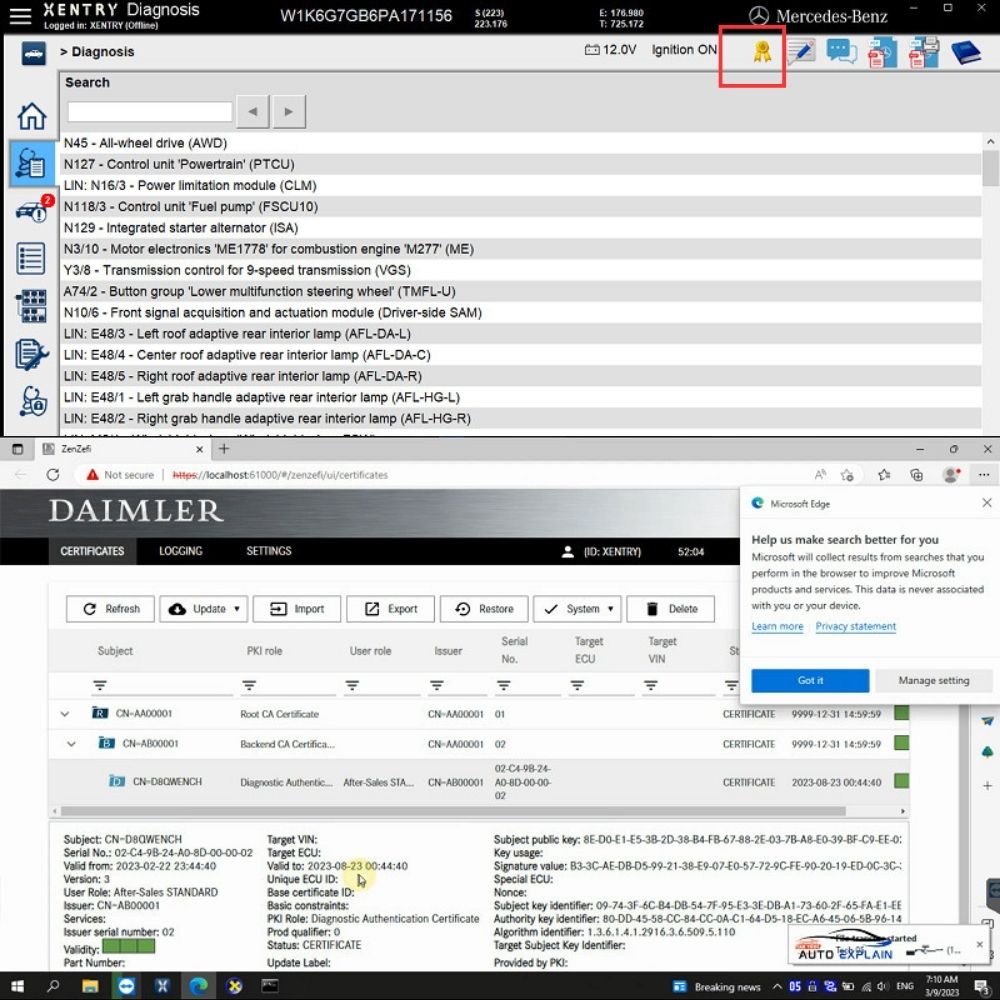
What is the Xentry Certificate Zenzefi? Why You Need It, and When It Is Required?

Master VAG Coding vs VAG Expertise: Which Training Book Is Better?


New Mercedes Car Coding Solution with ZenZefi certificate for DTS Monaco 9.02






